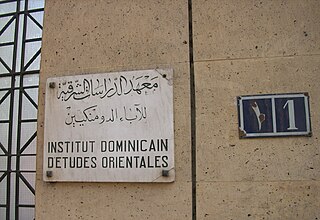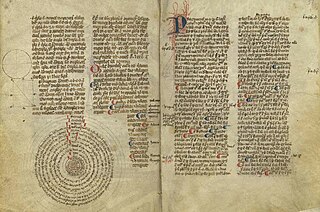
The Order of Preachers abbreviated OP, also known as the Dominicans, is a Catholic mendicant order of pontifical right founded in France, by a Spanish priest, saint and mystic, Dominic. It was approved by Pope Honorius III via the papal bull Religiosam vitam on 22 December 1216. Members of the order, who are referred to as Dominicans, generally carry the letters OP after their names, standing for Ordinis Praedicatorum, meaning of the Order of Preachers. Membership in the order includes friars, nuns, active sisters, and lay or secular Dominicans. More recently there has been a growing number of associates of the religious sisters who are unrelated to the tertiaries.

Blackfriars Priory is a Dominican religious community in Oxford, England. It houses two educational institutions: Blackfriars Studium, the centre of theological studies of the English Province of the Dominican Order ; and Blackfriars Hall, a constituent permanent private hall of the University of Oxford. The current prior of Blackfriars is Nicholas Crowe, and the regent of both the hall and the studium is John O'Connor. The name Blackfriars is commonly used in Britain to denote a house of Dominican friars, a reference to their black cappa, which forms part of their habit.

The University of Seville is a university in Seville, Spain. Founded under the name of Colegio Santa María de Jesús in 1505, at 2022 has a student body of 57.214, and is ranked 6th among Spanish universities.

The Basilica of Saint Sabina is a historic church on the Aventine Hill in Rome, Italy. It is a titular minor basilica and mother church of the Roman Catholic Order of Preachers, better known as the Dominicans.

The Summa contra Gentiles is one of the best-known treatises by Thomas Aquinas, written as four books between 1259 and 1265.
A pontifical university is an ecclesiastical university established or approved directly by the Holy See, composed of three main ecclesiastical faculties and at least one other faculty. These academic institutes deal specifically with Christian revelation and related disciplines, and the Church's mission of spreading the Gospel, as proclaimed in the apostolic constitution Sapientiachristiana. As of 2018, they are governed by the apostolic constitution Veritatis gaudium issued by Pope Francis on 8 December 2017.

The Pontifical University of Saint Thomas Aquinas (PUST), also known as the Angelicum in honor of its patron the Doctor Angelicus Thomas Aquinas, is a pontifical university located in the historic center of Rome, Italy. The Angelicum is administered by the Dominican Order and is the order's central locus of Thomist theology and philosophy.

Tartessian is an extinct Paleo-Hispanic language found in the Southwestern inscriptions of the Iberian Peninsula, mainly located in the south of Portugal, and the southwest of Spain. There are 95 such inscriptions, the longest having 82 readable signs. Around one third of them were found in Early Iron Age necropolises or other Iron Age burial sites associated with rich complex burials. It is usual to date them to the 7th century BC and to consider the southwestern script to be the most ancient Paleo-Hispanic script, with characters most closely resembling specific Phoenician letter forms found in inscriptions dated to c. 825 BC. Five of the inscriptions occur on stelae with what has been interpreted as Late Bronze Age carved warrior gear from the Urnfield culture.

Raymond of Penyafort was a Catalan Dominican friar in the 13th century, who compiled the Decretals of Gregory IX, a collection of canonical laws that remained a major part of Church law until the 1917 Code of Canon Law abrogated it. He is honored as a saint in the Catholic Church and is the patron saint of canon lawyers.
The Romani in Spain, generally known by the endonym Calé, or the exonym gitanos, belong to the Iberian Romani subgroup known as Calé, with smaller populations in Portugal and in Southern France. Their sense of identity and cohesion stems from their shared value system, expressed among the gitanos as the leyes gitanas.

Oriental studies is the academic field that studies Near Eastern and Far Eastern societies and cultures, languages, peoples, history and archaeology. In recent years, the subject has often been turned into the newer terms of Middle Eastern studies and Asian studies. Traditional Oriental studies in Europe is today generally focused on the discipline of Islamic studies, and the study of China, especially traditional China, is often called Sinology. The study of East Asia in general, especially in the United States, is often called East Asian studies.
Raymond Martini, also called Ramon Martí in Catalan, was a 13th-century Dominican friar and theologian. He is remembered for his polemic work Pugio Fidei. In 1250 he was one of eight friars appointed to make a study of oriental languages with the purpose of carrying on a mission to Jews and Moors. He worked in Spain as a missionary, and also for a short time in Tunis. A document bearing his signature and dated July 1284 shows that he was at that time still living.

François Savary de Brèves was a French ambassador of the 16th and 17th centuries as well as an Orientalist.

In the early modern France, Orientalism refers to the interaction of pre-modern France with the Orient, and especially the cultural, scientific, artistic and intellectual impact of these interactions, ranging from the academic field of Oriental studies to Orientalism in fashions in the decorative arts.

Rudolf Macuch was a Slovak linguist, naturalized as German after 1974.

The Dominican Institute for Oriental Studies is a center for fundamental research on the sources of Arab-Islamic civilization. Founded in 1953, it is located in Cairo.

Francisco García Tortosa is a Spanish University Professor, literary critic, and translator into Spanish. In Spain García Tortosa is considered one of the chief experts on the figure and work of the Irish writer, James Joyce, whose creations he has translated and about which he has published a wide range of studies. The Irish hispanist, Ian Gibson, has called García Tortosa «Spain's leading expert on Joyce», while considering his translation of Ulysses, in collaboration with María Luisa Venegas, as «prodigious».
Anna Parzymies is a Polish arabist, doctor of oriental studies, and professor at Warsaw University.

Pedro González Pérez, known as Pedro Gallego, was a Franciscan scholar and prelate. He was the first bishop of Cartagena from the diocese's restoration in 1248 until his death, and played a prominent role in organizing the church in the region of Murcia after 1243. He also compiled, abridged and adapted previous translations from Arabic into Latin, producing books on zoology, astronomy and economics.















